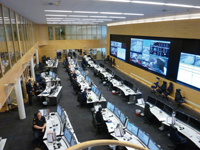|
“This is the main control room”, announces communications officer Conny Olofsson, surveying the ranks of desks and the big video wall in front of us. “This is the control room for Stockholm County.” In mid-morning, the quiet and calm atmosphere gives no clue to the volume of police activity the operators routinely deal with. “The peak time starts about 13:00”, Conny continues. “Then it reaches higher and higher and higher, and at about 19:00–20:00 we have a dip, and then it rises again. If it’s a Friday or Saturday night, then we are all on the top!” Not all of the desks are staffed at present. But in 24 hours, the 36 operator positions may handle some 3500 emergency telephone calls and around 3000 radio calls over Rakel, Sweden’s TETRA-based public safety network. Serving a population of 1½ million in the Swedish capital and the surrounding area, this is one of 20 police control rooms nationwide, although some of them are expected to be merged in due course into a few larger centres, for improved efficiency. “The screens you see – currently they are looking at hockey and traffic!”, notes Janis Lövgren, system architect for the national control room project. “But if you have a chopper [helicopter] in there, you would have the camera from that. If there are specific incidents, you would put the map on one of the big screens or the whole screen, and you would indicate certain areas on the map where the current incident is, where the resources are.” The desks, built by a specialist company, are used at all Sweden’s police control rooms. Each one can be adjusted electrically by a keypad which raises and lowers the screen platform and the main desk area independently. Operators of every size and operating habit can be accommodated, even if they prefer to work standing up. No cabling is visible anywhere; plugs and sockets are all on concealed panels. “Our goal is to standardize not just the systems but all the equipment as well”, comments Janis. “So they have the same tables, the same keyboard, mice, screens, everything. It’s a lot cheaper to maintain standardized systems than if everyone has their own.” Incident handlingCall-taking and dispatching are handled by the same operators. Each workstation is equipped with three screens, and the operators can arrange the screen layouts just as they wish. Settings such as window sizes and colours are saved to their personal login card so that they re-load them the next time they sign on. Nevertheless, the usual arrangement is to use the right-hand screen for mapping, the middle one for the Steria Storm command and control system (which registers each incident and manages resource planning and deployment), and the left-hand screen for Cortex, the integrated communications control system (ICCS) supplied by APD Communications. Unsually, these three functions are combined within a single computer for each desk – an integration project implemented in-house by the Swedish police technical team. Operation is by keyboard and mouse. Cortex was added to the existing control room systems in 2006 to support the TETRA radio platform. Through the Cortex screen, operators can access telephone circuits and radio talkgroups – not only on the Rakel TETRA network, but also on analogue radio. Similar workstations are also installed in a smaller standby control room located elsewhere, and in a separate area which is used for managing planned events, such as football matches or music festivals. In addition, it can be used for major police operations, to separate them from the everyday routine. “If you have a big incident like an unplanned withdrawal of large amounts of cash, that would probably move to a separate room”, says Janis, dryly. “When the fallback room is not in use for day-to-day operations, it is used for training”, he adds. “So we keep them up to date at all times. Otherwise there is no point in having a secondary control room.” Steve Denison, APD’s managing director, who is also visiting the control centre, observes: “Where people have fallback rooms, there is always the risk that, by the time they come to need it, somebody has borrowed a few bits!” Going liveSweden’s TETRA project was under way as long ago as 2001, but the project to update the command and control room systems of the county police forces, to adapt their old Ericsson analogue radio systems and to connect to TETRA, began in 2005. The new digital network went live in the following year, initially in the southern city of Malmö.
|

 Richard Lambley visits the Swedish capital to see a large, modern police control room which is tightly integrated with the national
Richard Lambley visits the Swedish capital to see a large, modern police control room which is tightly integrated with the national